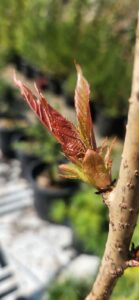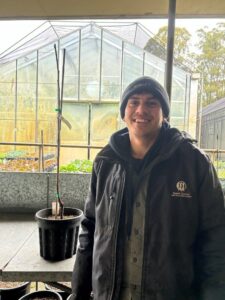
Inspiration from past stories
By Kobey Knight
As a young individual within this brilliant industry, I often find myself looking to the past, seeking milestone individuals’ horticultural acts for guidance or to be inspired by many of the stories I find.
This inspiration grows my dedication and determination to succeed, along with others in tackling climate change and preserving the genetic sequence of plants around the globe, no matter the size, shape and insignificant cultural value. They all have memetic and significant value to our biodiversity which we are surrounded by, from taking our first breath to our last.

With a background working in a Botanic Garden, one of my greatest passions is conserving plants and being able to share their importance and educate the next generation.
Throughout 2023 I had an amazing opportunity thanks to the Global Footprints Scholarship, which was sponsored by Mayfield Gardens, to work abroad in various Botanic Gardens in the United Kingdom and Italy. During this time, I stumbled across many unique and interesting plants. As I learnt and gathered a wealth of invaluable knowledge from likeminded professionals, there is one story that has remained with me more than a year after returning to Australia.
This story was told to me by one of my supervisors, Jake Robinson at the Royal Botanic Gardens, KEW. As we walked throughout the Kew arboretum, we encountered a large and magnificent Prunus serrulata ‘Tai Haku’, commonly known as the Japanese Great White Cherry tree. I gazed at this beautiful specimen, as I was told this story that was most inspiring, not because of how majestic this hybrid was, but more for its Japanese cultural value and how this hybrid was once thought to have been extinct in cultivation for more than a decade.
The story’s origins come from the famous plant collector Collingwood Ingram, who was later known as Collingwood ‘Cherry’ Ingram due to his appreciation of cherries as well as his collection. However, he would discover that his collection would be of great importance in reintroducing what was thought to be an extinct hybrid cherry.
In 1926, Collingwood was invited to address the Japanese Cherry Society. It was on this visit that he was shown a painting of a magnificent white cherry tree that had disappeared from cultivation. Ingram recognised the blossom as that of a tree he had found growing in a garden in the UK.
“Mr. Funatsu brought me out one or two old pictures of cherries amongst which was one by his great grandfather painted about 120 years ago. (Mr. F is an old man). This kakemono depicted very accurately, if crudely, the large flowered single cherry I found at the freeman’s which I have named Tai Haku. Apparently, its correct name being Akatsuki meaning “daybreak” or “dawn”. The fine shape of the flowers and its pure whiteness contrasting with the pale golden bronze young foliage are clearly depicted. The diameter of the flowers – about 6cm if my memory does not fail – is also about right in the painting. Mr. Funatsu said he had long been searching in vain for this Aksatsuki variety! It is a curious thing that it should be found again in a remote Sussex Garden.”

– from the journal of Collingwood Ingram, 1926.
Determined to prove his identification to be accurate, Ingram returned home and succeeded in sending a scion halfway around the globe embedded in potatoes. This would have some problems due to the rise of World War 2. The scion would eventually arrive in Japan, thus, successfully reintroducing the Great White Cherry, renamed “Tai Haku”, to its rightful home. That first cutting, now developed into a full-grown tree, can still be found in a nursery in Kyoto.
As you can imagine, returning from my trip eager to create change, and share some of what I had learnt on my journey as well as my appreciation, I decided to donate a specimen of the Great White Cherry to Mount Lofty Botanic Gardens. This donation will ensure this story will continue to be shared with many individuals, along with a deeper meaning that demonstrates that when communities work together, in alliance, amazing things can happen with conservation, such as the cultural significance that the ‘Tai Haku’ held for Japan.
There are many amazing projects happening around the world preserving plants such as the famous Wollemia nobilis. However, I am sure that just like the story of the Great White Cherry there are many untold stories still waiting to be heard. I hope you enjoy this one as much as I did.
All images supplied by Kobey Knight
